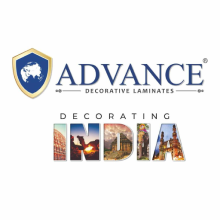Make the Right Choice with Advance Block Boards
What Is Blockboard?
Blockboard is made up of softwood strips and veneers. The Laminated Plywood is manufactured by placing softwood strips edge to edge and sandwiched between veneers and then this sandwich is glued together with high pressure. Block boards are generally used to make wardrobe doors, doors, panelling, and partition walls. It comes two varieties viz., 25mm blockboard, and 19mm blockboard. The Laminates Blockboard is mostly used when there is a lengthy piece of wood is required which makes furniture stiffer or and prevents it from bending block board price. While using Blockboard always take care that the core of Blockboard runs lengthwise, to achieve maximum strength. Block Boards are made out of the excellent quality of Plantation Timbers. Logs are quarter sawn into Planks using the SDR method, which is chemically treated and well seasoned before converting into battens in multiple ripsaws. Battens are sandwiched between two glued mechanically dried veneers and are pressed in a hot press under accurate temperature and pressure. Quarter sawing of logs and proper seasoning of planks make it dimensionally stable and treatment of planks, poisoning of the glue line, and preservative treatment of finished blockboard makes Advance Block Boards durable and safe against borers. These are available in two major varieties viz., 18mm plywood, commercial block board, Laminated block board, pine block board and 12mm plywood.
Properties of Blockboard
- Poor conductor of Sound, Heat, Electricity
- Block boards are stable, light and easy to cut
- It has good dimensional stability so is highly resistive to wrapping and cracking
- It is light in weight than plywood due to its softwood which extends the life span of furniture
- Compare to another competitive material life span of Blockboard is more than plywood.
APPLICATIONS
Cabinets, Almirahs, Door Partitions, Shelves, Interior Applications; Such As Roofing, Fencing, and Other External Applications.
- Kitchen Plywood
- Waterproof Plywood
- Wardrobe Plywood
- Veneer Plywood
- Kitchen Plywood
- MDF Plywood
- Commercial Plywood
Technical Properties of Block boards
- Modulus of elasticity long
- Density
- Bending strength
- Bending strength cross
- Formaldehyde emission
- Modulus of elasticity cross
- Fire safety category
- Thickness tolerance
- Length and width tolerance
- Processing of Blockboard
Followings are the steps of blockboard processing:
- Slicing
The logs of timber are sliced at first for making the raw of blocks. Strips may be 25 mm.
- Rotary Cutting
For the outer layer, logs are cut at rotary cutting. Thus veneer for coating is obtained.
- Glueing
To attach the slices glue or adhesives are used such as Urea-formaldehyde, Phenol formaldehyde which is called plastic resin. The exterior grade block board requires phenol-formaldehyde. Glueing is done under high pressure.
- Drying
The blocks are dried to reduce the moisture as well as water content left inside blocks. For drying the blocks are kept before the sun. The moisture content is reduced to 10-12%. After proper drying, they are ready for making a sandwich.
- Attaching
Blocks are attached together used softwood or hardwood as required for interior or exterior grade required.
- Finishing
Final finishing giving lamination, a coating is done.

